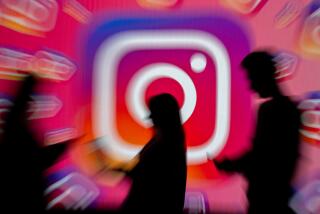And the ‘Muddy’ Goes to: Some of the Ugliest Web Sites in the World
- Share via
The Webby Awards--the Internet’s aspiring equivalent of the Oscars--applauded a few brilliant Web sites last week. In a parallel spoof, the Mud Brick Awards ridiculed sites that seem to capture the essence of most of the rest: ugly, indecipherable, time-wasting, colorblind or otherwise aesthetically challenged.
The “Muddies” (https://www.netstudio.com/mudbrick/), brainchild of Manish Vij, chief executive of NetStudio Corp., a producer of Web design software for novices, seem to have been created as a promotional vehicle but are painfully on target when it comes to identifying a central reality of the Web experience.
Mud Brick judges looked for a combination of amateurism, weak branding, graphical inconsistency and navigation impairment. The semifinalists (“winners” won’t be announced for a couple of months) must have been hard to choose--so many sites boast the proper criteria--but these examples will give you the idea: https://www.quakeroats.com (site index as home page), https://www.southwest.com (a tacky look for a discount airline) and https://www.scopesys.com (check for the animated yellow smiley face).
That’s a start, but I’d add a few other Web-design peeves:
* News sites that make you click for every three paragraphs of a story. (It’s a way to show you more ad banners.)
* Pass-through home pages that offer no content yet load slowly.
* Wired-esque Day-Glo colors or dark writing on a dark background.
* Corporate sites that, like the welfare system, seem designed to discourage people by making them jump through a baffling obstacle course to get a simple fact. (Try looking for the company address on IBM’s site or for the phone number on Microsoft’s in fewer than 10 maddening clicks.)
“Essentially, 99% of all Web sites are hideous,” said Roger Black, Web design guru and chairman of the New York-based Interactive Bureau.
Black partly blames technology.
“The [Microsoft] people in Redmond [Wash.] don’t like to admit it, but Windows scares a lot of people. It reminds them of work.” And the lingua franca of Web publishing, HTML (hypertext markup language) remains tough to use with finesse.
“The Web’s ability to display graphics [ranges between] minimal and bad,” and getting sites to work smoothly still requires heroic efforts, said John Warnock, chief executive of Adobe Systems, the leading design-software company. Typography and printing controls remain particularly primitive, he said.
Adobe is pushing for a new Internet standard called SVG--scalable vector graphics--that should help.
“The other problem is the committee mentality of almost all Web work,” said Black. “Nothing is edited--most of it is just shoveled on the site.”
*
Black’s anecdotal conclusions were validated by a report released late last year by Forrester Research, a market analysis group in Cambridge, Mass. Few Web publishers measure ease of use, and only a quarter conduct user testing, Forrester found. In usability tests, only 12% of sites surveyed delivered any content without requiring clicks through two or more layers of menus. The vast majority of sites suffered legibility and search problems--routinely delivering irrelevant information or broken links.
Of course, even when designers build carefully and get feedback from users, there’s little agreement on what works. Two design poles have emerged:
“New and cool” designs lard sites with animation and complex images that (unless you have a high-speed Internet connection) offer the chance to grab a nap between clicks. The “utilitarian” alternative packs as many text links as possible on a page--a dull but snappy approach that Black calls “Yahoo-ization,” after the top portal site.
Each approach has its place.
“You want your video games to be cool, but you don’t want your banking to be cool,” said Black. “If I were publishing a novel, I wouldn’t want it to look like the phone book.”
And like any art form, success comes in infinite forms between the poles--such as these:
* https://www.salonmagazine.com (sophistication and style)
* https://www.lynda.com (Web designer Lynda Weinman demonstrates pleasing simplicity)
* https://www.gap.com (even buying can be an elegant experience)
* https://www.askjeeves.com (Black’s current favorite--a general-interest site that doesn’t cram in all of cyberspace)
* https://www.apple.com (a Warnock pick; you’d expect Apple Computer, which created the first and best computer for publishing and graphics, to understand design).
It’s hardly surprising that such gems are relatively rare. Like desktop publishing a decade ago, the Web is a fundamentally democratic medium that opened up new realms of expression and, well, bad taste, to the masses.
“When we started giving people access to fonts, they started using all of them in every document. The world of typography reacted in horror,” and it took years before the new publishers gained a sense of equilibrium, recalls Warnock, who was a progenitor of desktop publishing. Getting nascent Web designers to quit gorging on eye candy will take just as long, he said.
*
But Black sees a more rapid transition to making readable, creative and useful sites commonplace, partly because people have embraced the Web much more quickly than they did desktop publishing. That staggering adoption rate and the impending transition to high-speed Internet connections bodes well for Web design.
So hold your nose as you click, but keep on clicking. Like all things Internet, it’s changing fast.
Times staff writer Charles Piller can be reached via e-mail at charles.piller@latimes.com.





